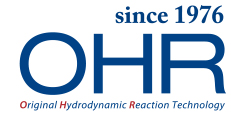Ensure the mechanism follows the fundamental laws of physics
Difficulties in dissolving oxygen into water
Oxygen does not readily dissolve into water. And because air is some 773 times lighter than water, air bubbles rise rapidly in it. What truly demonstrates the quality of an air diffuser manufacturer’s technology is how they tackle the thorny issue of instantaneously dissolving oxygen into water. Whether there is a structure that enables instantaneous gas–liquid contact and dissolution of oxygen into water — which diffuser is superior all comes down to this.
Porous air diffusers and the contact area myth
Porous air diffusers, with their array of fine pores each a few hundred microns across, are based on the following vague notion: by simply discharging fine uniform air bubbles, contact area with the water will increase, the bubbles will rise more slowly, bubble residence time will increase, and therefore ultimately oxygen will readily dissolve into the water. This is, in a way, logical, but whether this oxygen actually dissolves is left entirely to chance. As soon as the make-up of the water changes (e.g. it becomes full of impurities), the OTR (Oxygen Transfer Rate) falls significantly. For more details, please see the link below.
This complete inability to forcibly dissolve oxygen into water is a serious shortcoming of porous air diffusers.
When it comes to vertical air diffusers,
how they achieve instantaneous gas–liquid contact is everything
On the other hand, the mechanism of vertical air diffusers (as typified by the OHR AERATOR) works by first discharging coarse bubbles. Such bubbles have an extremely small contact area and rise remarkably quickly, hence the vital importance of a way of achieving full, instantaneous contact between air and water.
Prior to the OHR AERATOR, no air diffuser was capable of mixing gases and liquids. Our key innovation was to introduce special internal structures, designed according to the principles of fluid dynamics, that are able to instantaneously collide and react them. As a result, the OHR AERATOR has garnered an excellent reputation both for its effectiveness in wastewater treatment and for its ability to accelerate chemical reactions.
Several other vertical air diffusers have recently come onto the market since it has become common knowledge in the wastewater treatment industry that all air diffusers require a mixing function. However, non-OHR diffusers of this type have internal structures that are either excessively complicated (high risk of clogging) or excessively simplistic (low efficiency). There are confirmed cases of non-OHR vertical air diffusers becoming clogged with activated sludge, MBBR carriers, and fallen leaves.
See the link below for real-world examples of the OHR AERATOR in action.
Base your decision on whether the mechanism makes logical sense
More important than anything else is whether the mechanism is logical (i.e. it has a sound theoretical basis).
Air diffusers can be used under extremely harsh conditions, such as:
- Demanding instantaneous contact of gases and liquids that separate in an instant;
- Pumping a stream of hot air while constantly under pressure, several meters underwater; and
- Demanding long-term, stable, clog-free operation with liquids that contain high concentrations of solid material.
Although there are air diffusers on the market that copy OHR’s mechanism explanations without the corresponding structures, as well as those apparently created without much thought, it is evident that such diffusers, lacking solid backing, are useless in actual wastewater treatment situations.
Because air diffusers are fundamentally gas–liquid "reaction promoters", it is paramount that the mechanism be based on physicochemical laws. The OHR AERATOR’s unique mechanism applies principles from aerodynamics to enable powerful gas–liquid mixing without clogging.
Please see the link below for a diagrammatic overview of the OHR AERATOR’s mechanism and objective comparisons with other companies’ diffusers.












